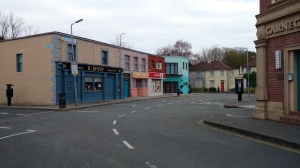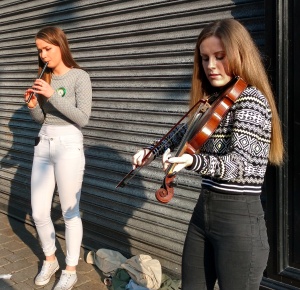Dublin is Ireland’s political, economic, and media center, with nearly half the country’s population in its environs. That makes it a bit like New York (commerce and finance), Washington (politics) and Los Angeles (media/entertainment) rolled into one. As an aside, London — where I have spent some time — is a similar multiplex for the UK.
On my first trip to Dublin with a student excursion back in January, honestly I wasn’t too impressed. The things we did with the students were interesting enough but the city in general seemed just too busy and sort of sterile. It reminded me of London, but with less charm.
But I have spent a couple of more days there recently and had a better time of things, largely because of the people I have met and the places I have been able to see. (This post actually got started in a neat little old-fashioned pub where I stopped to pass the time waiting for my bus back to Galway.)
Monday in Dublin
My two days in Dublin started on a Monday when I traveled there for a tour of Google’s main European office. This came about through a connection I had made on the plane flight over here in January. On that flight, I was seated next to a young American woman who is among the 4,000-strong workforce for Google here in Ireland. During our conversation she offered to have me visit the offices. It took more than two months for our schedules to sync up but I finally was able to travel there for a tour, which was very interesting.

 After that, I visited the main offices for RTE, the national broadcaster. My tour guide was the organization’s head of innovation, who showed me some of the back lots and TV and radio studios there. Interestingly, we had met virtually, via social media, through a mutual acquaintance but met in person for the first time when I made this visit.
After that, I visited the main offices for RTE, the national broadcaster. My tour guide was the organization’s head of innovation, who showed me some of the back lots and TV and radio studios there. Interestingly, we had met virtually, via social media, through a mutual acquaintance but met in person for the first time when I made this visit.
With my developing interest in Irish media, it was fantastic getting the inside view of RTE’s operation. The one disappointment is that we could not see the nightly news studio because even though it was not the time for a regular broadcast, it was in use for something.
Tuesday in Waterford
My Dublin visit was two days spread over three days, taking place on a Monday and a Wednesday while on the Tuesday in between I went to Waterford for a visit with some friends who work at Waterford Institute of Technology.
One extremely interesting part of the WIT visit was seeing part of the campus that consists of buildings from the early 1900s originally built as a Magdalene laundry. It operated as such until the 1970s, according to my friend and tour guide Walter. The Magdalene institutions are an unsavory, but undeniable, part of Ireland’s past because of how misogynist and exploitative they were. It was easy to sense the ghosts of the women and children affected by what that took place there.
I also had lunch with the editor of the Waterford-based Munster Express, Kieran Walsh, and met some of the reporters from the paper. In the evening I attended an entertaining theater production with my friend Jean, also a WIT professor. The trip from Dublin to Waterford and back was by train, which was a very nice way to travel.
And back to Dublin
When I returned to Dublin on Wednesday it was a for a meeting with a member of the Dail (national legislature) who wanted to get together because he has a connection to Rochester recently brought to his attention by my friend and colleague Tim Madigan. (Not going into that in detail here because it is covered in a blog post of its own.) After that, I met with Joe Humphreys, another friend of Tim’s, who works at the Irish Times. This gave me an opportunity to see the paper’s newsroom and talk about his perspectives on the changing Irish media.
Since the train on Wednesday got me to Dublin well before the meetings, I was able to do some sightseeing of places related to the 1916 Easter Rising, just days before the formal commemoration of it, and also to exhibits at the National Library about the Rising and about Ireland’s role in World War I.
Overall, it was a brilliant trip, full of interesting conversations with people whom I really enjoyed meeting for the first time or getting reacquainted with, plus some sightseeing and discovery of a cool little pub. I thought after my January visit that I was done with Dublin, but perhaps not.












